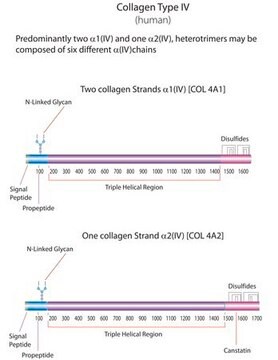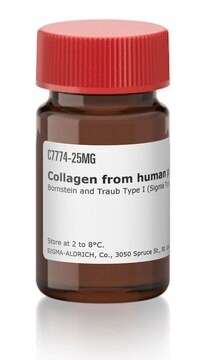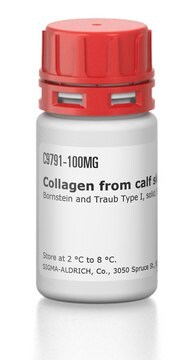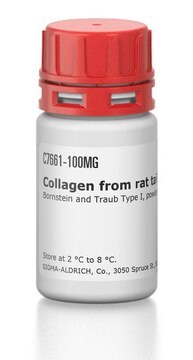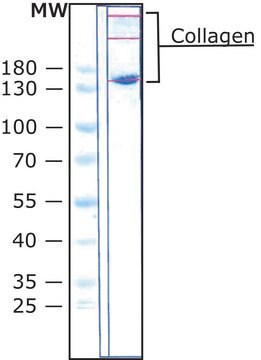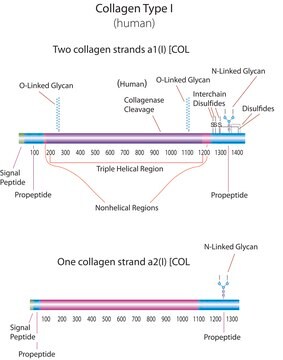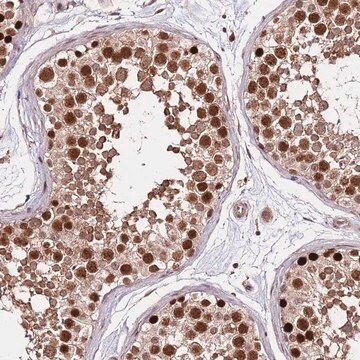Kluczowe dokumenty
C5533
Human Collagen Type IV
from human placenta, powder, suitable for cell culture
Synonim(y):
Collagen Type 4
About This Item
Polecane produkty
product name
Collagen from human placenta, Bornstein and Traub Type IV, powder, BioReagent, suitable for cell culture
pochodzenie biologiczne
human placenta
Poziom jakości
linia produktu
BioReagent
Postać
powder
opakowanie
pkg of 5 mg
metody
cell culture | mammalian: suitable
zanieczyszczenia
HIV, hepatitis B and hepatitis C, none detected
rozpuszczalność
acetic acid: 0.5-2.0 mg/mL (Dissolve for several hours at 2-8 °C, occasionally swirling.)
Specyficzność wiązania
Peptide Source: Collagen Type IV
temp. przechowywania
−20°C
informacje o genach
human ... COL4A1(1282) , COL4A2(1284) , COL4A3(1285) , COL4A4(1286) , COL4A5(1287) , COL4A6(1288)
Szukasz podobnych produktów? Odwiedź Przewodnik dotyczący porównywania produktów
Opis ogólny
Zastosowanie
- To solubilize extracellular matrix for surface functionalization.
- To induce endothelial cell and rat pluripotent cell differentiation.
- As an adherent in cell migration/invasion assay.
- To assess the bioelectric effects of quinine on airway epithelial cells.
- To study the selective toxicity of engineered lentvirus lytic peptides.
- In particle aggregation assay for the rapid detection of fibronectin, fibrinogen and collagen receptors on Staphylococcus aureus.
- In a magnesium-dependent, collagen-binding assay during characterization of human lung tumor-associated antigens.
Działania biochem./fizjol.
During development, collagen IV is ubiquitously distributed in the basement membranes (BMs). During the maturation process, this network gets partially replaced in a remarkably tissue specific manner, defining the BM structure and function. Collagen IV has been shown to bind to platelets, hepatocytes, keratinocytes, endothelial, mesangial, pancreatic cells and some tumor cells.
Tissue injury in the autoimmune disease, Goodpasture syndrome, is due to the pathogenic autoantibodies targeting the collagen IV α3 chain. Mutations in the COL4A5 gene are associated with Alport syndrome.
Przestroga
Uwaga dotycząca przygotowania
Inne uwagi
Kod klasy składowania
11 - Combustible Solids
Klasa zagrożenia wodnego (WGK)
WGK 1
Temperatura zapłonu (°F)
Not applicable
Temperatura zapłonu (°C)
Not applicable
Środki ochrony indywidualnej
Eyeshields, Gloves, type N95 (US)
Certyfikaty analizy (CoA)
Poszukaj Certyfikaty analizy (CoA), wpisując numer partii/serii produktów. Numery serii i partii można znaleźć na etykiecie produktu po słowach „seria” lub „partia”.
Masz już ten produkt?
Dokumenty związane z niedawno zakupionymi produktami zostały zamieszczone w Bibliotece dokumentów.
Klienci oglądali również te produkty
Produkty
Attachment Factors for 3-Dimensional Cell Culture
Macierz zewnątrzkomórkowa (ECM) i jej składniki czynnika wiążącego są omówione w tym artykule w odniesieniu do ich funkcji w biologii strukturalnej i ich dostępności do zastosowań in vitro.
The extracellular matrix (ECM) is secreted by cells and surrounds them in tissues.
Przegląd hodowli komórek 3D. Dowiedz się więcej o hodowli komórek 2D i 3D, zaletach hodowli komórek 3D i technikach dostępnych do tworzenia modeli komórek 3D
Nasz zespół naukowców ma doświadczenie we wszystkich obszarach badań, w tym w naukach przyrodniczych, materiałoznawstwie, syntezie chemicznej, chromatografii, analityce i wielu innych dziedzinach.
Skontaktuj się z zespołem ds. pomocy technicznej
